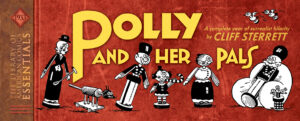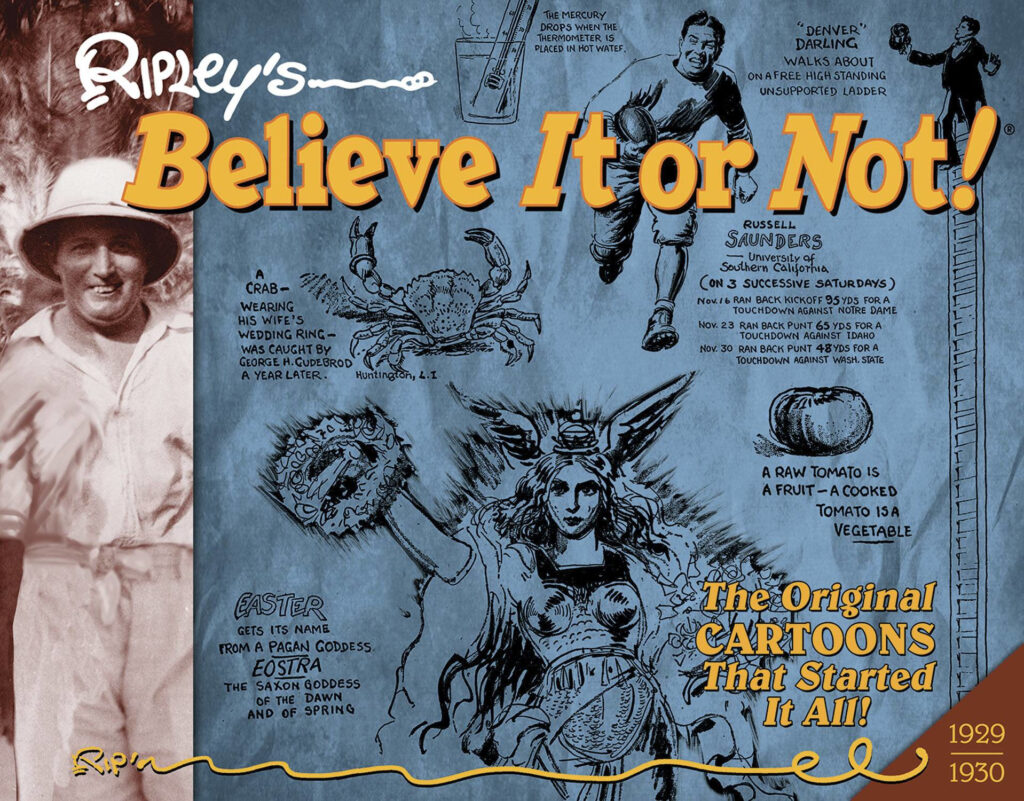
By the early 1930s Cliff Sterrett had transformed Polly and Her Pals into the world’s premier surrealistic comic strip. Polly debuted in 1912 as one of the earliest “pretty girl” strips, but it was in 1925 that Sterrett entered his peak period, developing a new style replete with Art Deco decorations, abstract backgrounds, and distinctive surreal perspectives—all within the context of a down-right hilarious situation comedy. Sterrett’s Sunday pages (also being published by The Library of American Comics) have long been hailed as individual masterpieces, but his daily strips—due to their rarity—have eluded archivists for the past ninety years. The discovery by the Library of American Comics of syndicate proofs for some early 1930s dailies—plus new information about Sterrett’s involvement with a Maine-based artist colony—fills a major hole in comics history. The strips reprinted here—the complete year of 1933 dailies—show Sterrett at his most inventive, building gags upon gags within one- and two-week continuities, culminating in a spectacular holiday story in which the entire cast—Polly, Maw and Paw Perkins, cousin Ashur, Neewah, and the rest of the outrageous Perkins household—is transfigured into living, breathing Christmas dolls.
- Library Of American Comics, August 2013
- ISBN 978-1-61377-698-8
- 11.5” x 4.25”, 336 pages, hardcover
- $24.99 USD
- Order online: Amazon, Things From Another World, Biblio



This is a humour strip and follows the “gag-a-day” format, but Sterrett works a storyline for several weeks before moving in. The farm setting in this volume runs for four months, a staggering length of time, but it allows for pretty much every possible gag to be wrung out.
An excellent example are the few weeks Paw got a new car. First it was the issues with the current car, then looking for and negotiating a new car, then pampering the new car. A lot of great material, including not wanting to drive anywhere, babying the new car, and even sleeping in it to get that new car experience. The gags were thoroughly worked through, but Sterrett knew when to quit and move on.
As mentioned earlier, the family moves to the country for the summer and this escapade takes four months of dailies. Yet it never feels stale or tired: it was such a change for the characters that every adventure captivates. Sadly we see Sterrett working “blackface” for his African-American characters, who are all in servant roles. It’s par for the course in 1933 but cringe-worthy today.
While it may be titled Polly and her Pals, it’s all about Paw. Polly is a pretty face amongst characterized family members; she brings fodder through her various beaus. The extended family allows for a variety of scenarios without tiring out the reader with the same old faces.



Sterrett’s art style is unique and visually striking. He excels at facial expressions and body language, all with his exaggerated angles. And let’s not miss the textures and patterns worked into the fabrics and environments. He can take the strip from the mundane to the fantastical with equal skill, as the last storyline demonstrates as all the characters become nutcrackers until Christmas.
The strips are well presented, with no visual issues. The use of syndicate proofs really shows; these look great.
The design builds on the established framework for this Essentials line, working character cutouts and fonts effectively. Each page has the date and page number, strip topper with name, title of that day’s strip, and artist. The strips are presented one to a page, giving the largest presentation of dailies from LOAC. There is no colour in the interior of the book as befitting the effort to mimic reading these in a 1933 newspaper.
Production is excellent, with this hardcover having a sewn binding of cream matter paper stock with a “newspaperish” feel and weight. The size can be awkward to hold in your hand but works well in the lap. Plus we get that essential LOAC silk ribbon.



Perhaps my favourite part of each daily is looking for the cat and what position or pose Sterrett chose for that day. Mostly it’s in lockstep with Paw, but it’s like a hidden treasure to seek out.
Like most humour strips, these are best consumed in small daily doses. Because of Sterrett’s approach to storylines, you can read a week or two and not get burned out. The format of one strip per page also helps keep the reader engaged and rooted in that one daily.





